How to Write an SEO-Optimized Blog Post (Step-by-Step)
Georgi Todorov
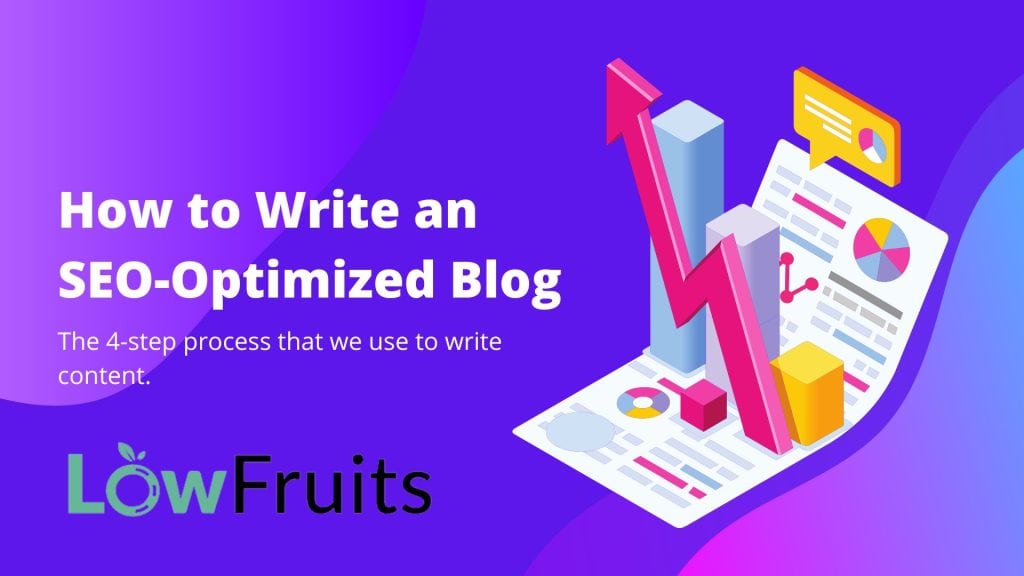
Regardless of whether you are a beginner in SEO or a professional with years of experience, one question still stands:
How to optimize my blog content for SEO?
In this article, we are going to touch base on everything On-Page SEO for blogs:
- Our step-by-step process for writing SEO-optimized blog posts
- Tools that can help you along the way
- What you should keep in mind when creating content
- Every detail that would move the needle of your SEO efforts
At the beginning, it will feel like a checklist, but as you progress with content creation, you will be doing this on autopilot when you get used to it.
How to Write SEO-Friendly Blog Posts
We will walk you through our 4-step process of creating SEO-friendly content.
Step #1: Research the primary and secondary keywords
The primary keyword is the main keyword phrase that you want to target with your blog post.
For example, ”London travel guide” for your travel website.
You also want to come up with secondary keywords. These will be your long-tail keywords or closely relevant keywords to the topic.
In order to come up with such secondary keywords, you can use SEO keyword research tools like LowFruits that generate thousands of ideas.
You just have to plug in your seed keyword (in this case, ”london”), and check out the ”questions” tab.
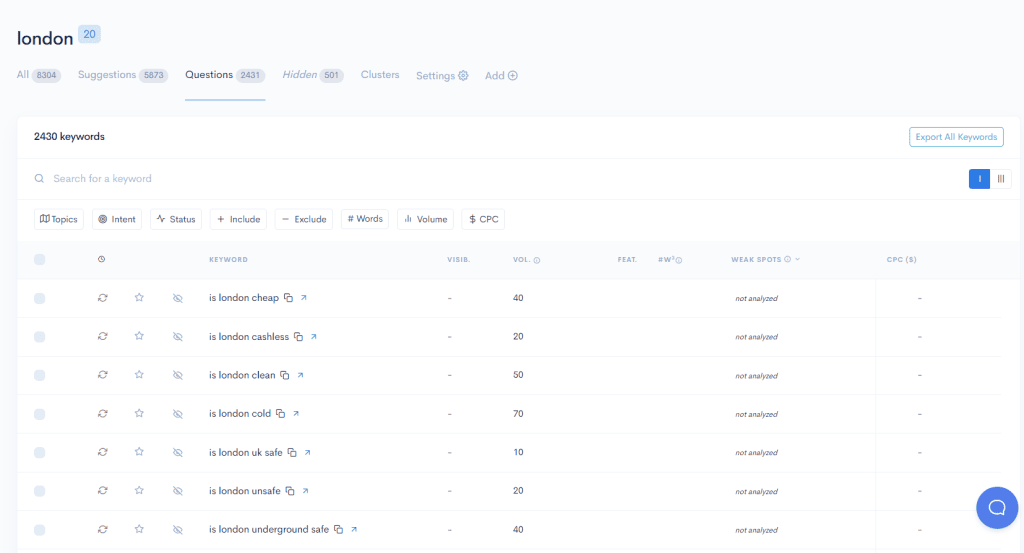
Here, we can see some secondary keywords that we can target for our travel guide, such as:
- Is London cheap?
- Is London cashless?
- Is London clean?
- Is London cold?
- Is London safe?
And around 2,000 other questions that we were able to generate with LowFruits.
From there on, it becomes a matter of prioritization – which keywords have sufficient monthly volume to go after them?
These questions would then be your H2 or H3 headers in the article and would be the founding structure of the article.
More on headers and content structure later.
Pro Tip: You can rank on 1st page or even on the first 3 results for your secondary keyword, as long as you are answering the question in-depth and the competition is not too fierce.
But the thing is, you can’t answer all of the 2,000 potential questions. The article would be a million words.
You will need to figure out exactly which 4-5 secondary keywords you would want to target.
In the beginning, we are only interested in the keywords that have a good monthly search volume but are not very competitive.
These would be keywords that have weak domains ranking on 1st page
Later down in the process, we will also look at what are the secondary keywords that the competitors are targeting with their content.
Step #2: Research the SERPs for those keywords
Alright, you’ve got 1 main and 4-5 secondary keywords that you want to target with your content.
The next step is to research the SERPs for those keywords.
You are interested in knowing how the competition has went on to write these topics.
The first step is to analyze the SERPs using LowFruits in order to evaluate the competitive landscape:
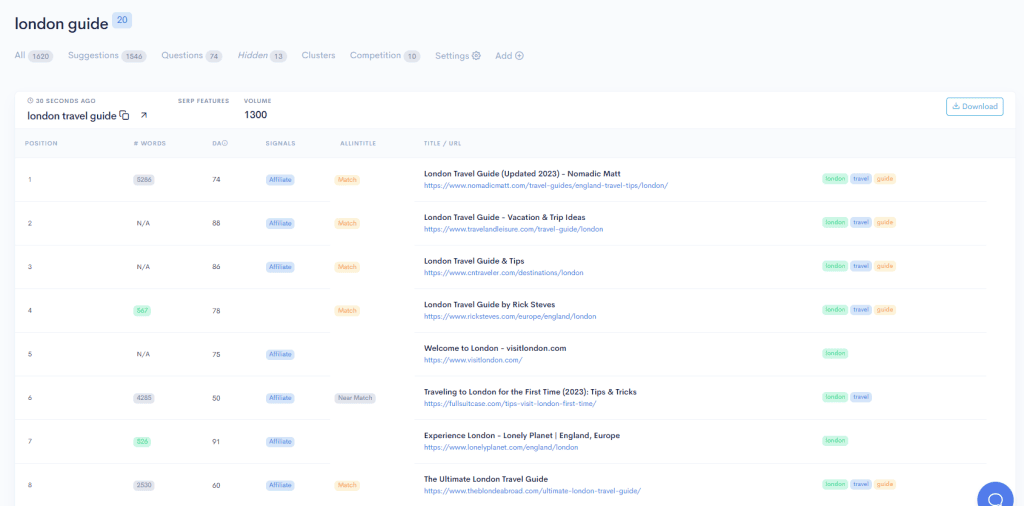
We can see that the top competitors have written upwards of 4,000 words on the topic. There are also some category pages ranking, hence why they have only 500 words on the page.
After that, we want to open the top 3 competitors and look for:
- Their content structure and outline
- What sub-topics are they covering
- What kind of imagery and tables are they using to improve user experience
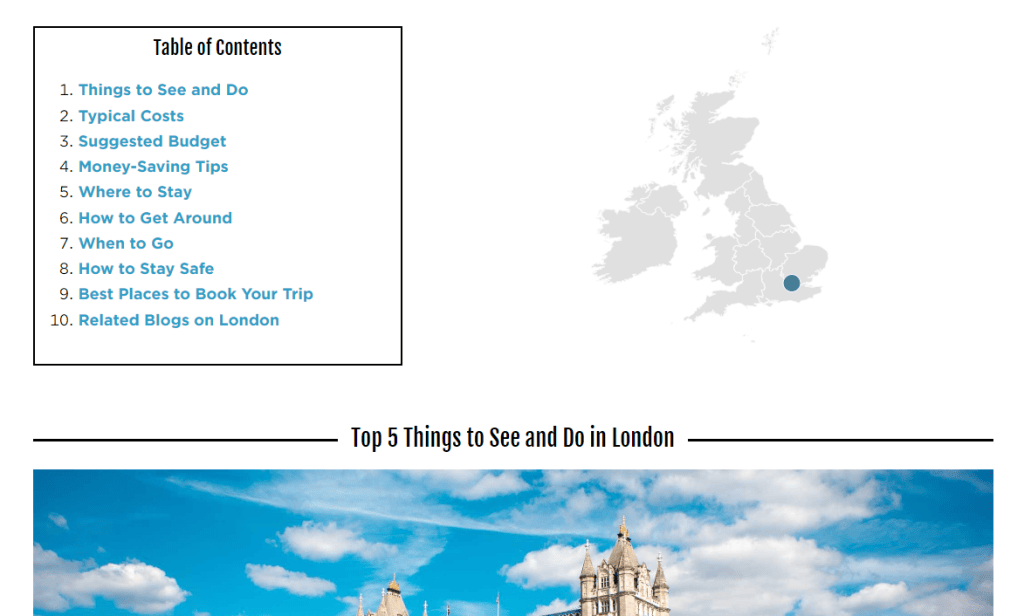
We are doing this because this is content and structure that Google believes deserves to be in the top 3 positions for that particular keyword.
In the previous section, we identified 4-5 long-tail keywords that have good search volume and weak competition, but here in the competitor analysis, we see that there are other topics that they are covering.
In this case, we can combine the ideas. We can write on what works and what Google believes makes sense, such as ‘’typical costs in London’’, while also expanding on more topics based on our keyword research.
And then these 2 types of keywords – that competitors have covered and that we were able to find to have a good volume/difficulty ratio, would be our secondary keywords.
The goal is not to copy your competitors word-for-word and section-for-section, but the goal is to see what works and what doesn’t work.
For example, if all of the top 5 results have been written on ”where to stay in London”, you’d probably need to write on that sub-topic as well.
And lastly, we want to check the actual SERPs by Googling our main keyword.
Our goal is to see the ”People Also Ask” tab in order to get additional question ideas that haven’t been covered by the competitors.
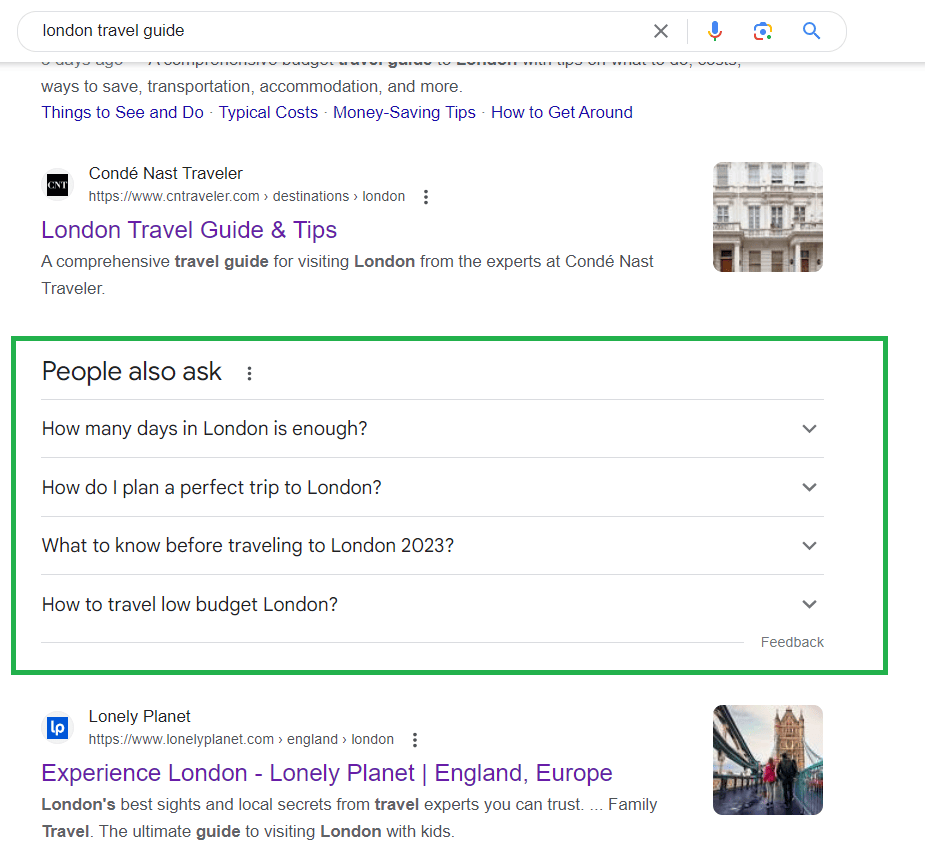
Pro Tip: You can rank for the questions on the ”People Also Ask” section as long as you answer the question in full and you showcase strong content relevancy.
Step #3: Write the content outline
So far so good – we know that we need to write around 4,000 words on our topic, and cover specific 7-8 questions under 5-6 subheadings.
We know what Google wants to be on the article. We also know additional topics that we could rank for due to their low competition.
Now it’s time for my favorite part of content creation: writing the content outline.
This is as good as getting half of the work done. If you have done your keyword research and you have analyzed the competition, this should be a relatively straightforward process.
Here’s what my hypothetical London content outline would look like:
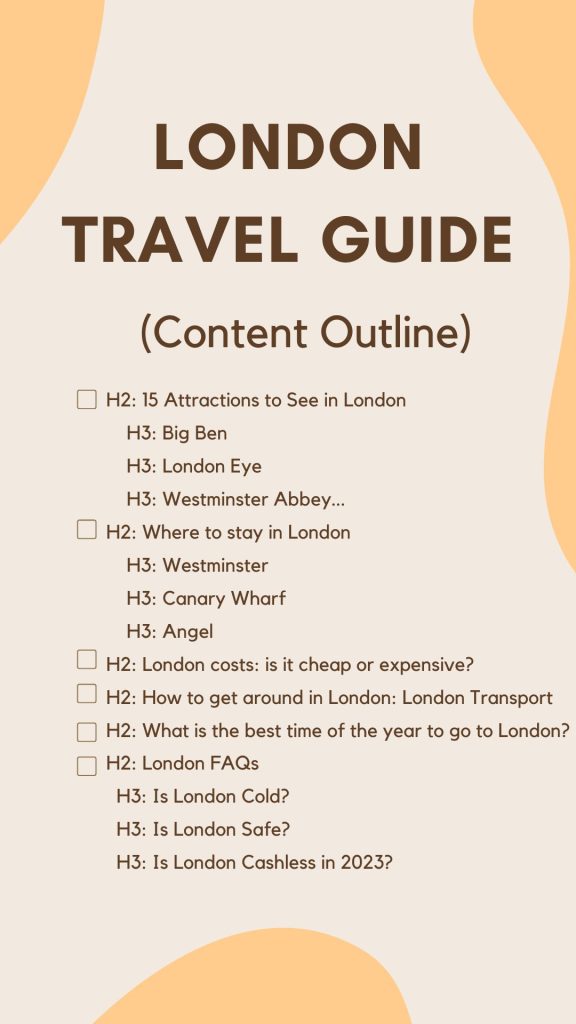
This is what a basic outline looks like, with H2s and H3s, featuring the keywords that we will be targeting.
You can take things a step further and write a detailed blog outline that includes search volumes and the competitive landscape:
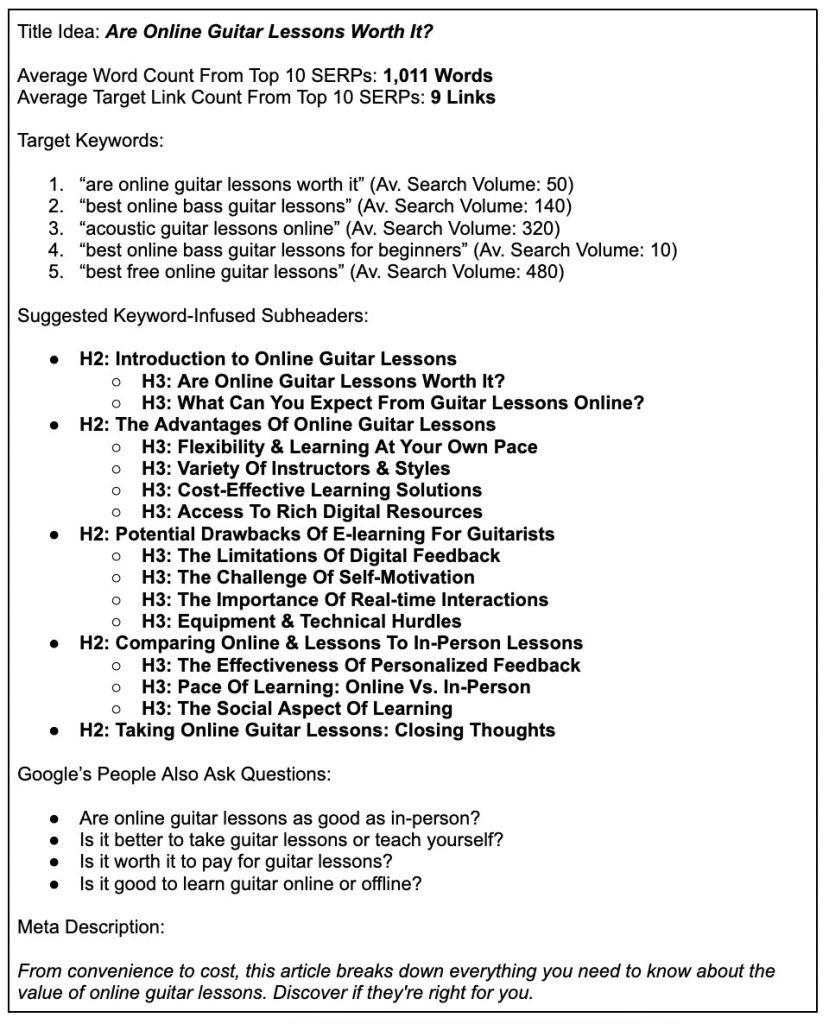
Step #4: Write an in-depth article on the main topic and its subtopics.
Creating a content outline does half the work, but writing the article thoroughly on the main and sub-topics is equally important to establish topical expertise.
To achieve topical relevancy, your content should delve deep, demonstrating your knowledge to both Google and your audience.
Enhance your user experience by going beyond your competitors’ content. For example, in our London Travel Guide, consider including up-to-date discounts at the time of posting.
Remember, optimization isn’t just for Google; it’s about delivering value to your readers.
When you are done writing and ready to publish, you should ensure that the main keyword appears:
- In the title of the article: ‘’The A-Z Travel Guide to London’’
- In the URL: ‘’example.com/london-travel-guide’’
- In the meta description: ‘’Read our London travel guide and explore the best places to visit and eat.’’
- The H1: ‘’The Ultimate London Travel Guide’’
- And in the introduction: ‘’This guide is the complete London travel guide.’’
And after that, focus on the secondary (long-tail) keywords in the H2 headers.
Secondary keyword as a separate article
Some topics should be addressed in separate articles to avoid content overlap from targeting the same keyword repeatedly. Google generally prefers unique articles for each keyword.
In specific cases, we employ secondary keywords not for ranking but to comprehensively cover a topic, boost topical relevance, and satisfy the reader.
To assess if a keyword is suitable as a secondary target with ranking potential, conduct SERP analysis. Check if top-ranking pages focus solely on the target keyword or mention it in a sub-section.
For instance, a search for ‘vodka calories’ reveals no article optimized solely for that keyword, but it’s part of a broader pillar article covering nutrition information.
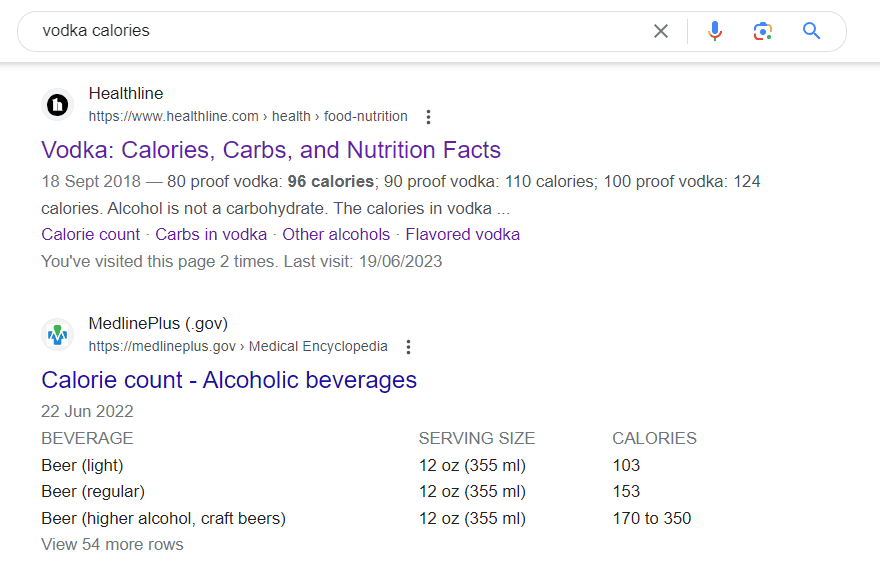
On the other side, we can see that if we research in Google ‘’the best places to stay in London’’, we can see that the SERPs are dominated by articles written only for that topic:
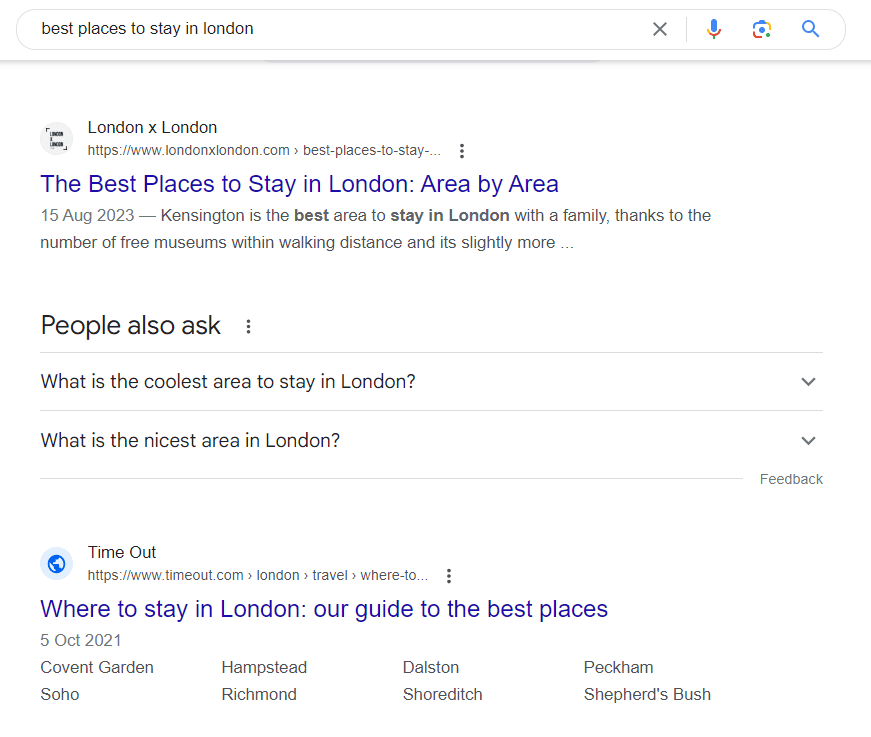
But that would not stop us from creating a sub-section on our ultimate London guide on this topic.
The reason for that is because the top results on Google have written on that topic, and Google has concluded that this is a topic of interest to the users.
It has become a part of building topical authority and satisfying user intent, and less for ranking for the keyword.
It has become a secondary keyword that is supportive to the primary keyword.
And if we want to target this keyword and rank for it, we would need to create a separate article, going in a lot further detail.
What I would do, is I’d make a sub-section of the best places to stay in London and I will include 2-3 neighbourhoods and 1-2 example hotels.
But in the ‘’complete guide on the best places to stay in London’’, I would include all the good neighborhoods with dozens of hotel ideas and additional tips.
You should only care about keyword cannibalization by content that is saying the same things.
If your website further expands on a certain topic and you write on that topic just in passing in another article, Google will prioritize your in-depth guide.
How many secondary keywords and topics to target?
The answer to that question usually depends on the topic itself, such as what is the competitive landscape and the rough word count you need to target.
In the case of an ‘’ultimate guide’’ kind of content piece, we would be interested in at least 7-8 secondary keywords or even more.
But if the topic is about ‘’transportation guide in London’’, the secondary keywords would be around 3-4, since we would be covering the underground, the busses, and the trains.
This is why competitor analysis is important as well as doing additional keyword research, because you want to be able to build a content outline that fully covers the topic.
8 content creation considerations
That concluded our 4-step process of creating content. But that’s not everything.
There are certain best practices that you should keep in mind when you are creating content.
These are optimizations and considerations for both the users and the search engines.
Tip #1: Build internal links
An internal link is when you point to another article on the same website. It’s called ”internal” because the users would not be leaving the website.
Internal links are crucial for building topical authority.
The reason why they are important is because, in front of Google, you are building connections between your content.
In our example from earlier, about the London travel guide, it would be a power move if we had other London or England-related content on our website that we could link to.
The end goal is to have topical clusters of pillar articles (such as an ”London ultimate guide”) and secondary supporting content, such as ”best restaurants in London”.
As a rule of thumb, make sure that your articles have at least 3-5 internal links.
You can briefly mention the other content that you have written around the topic.
Tip #2: Make the content scannable and consumable
Your content should be scannable. The content should be easy to read and easy to consume.
Let’s look at 2 of the competitors on our London topic. Which article would you rather read?
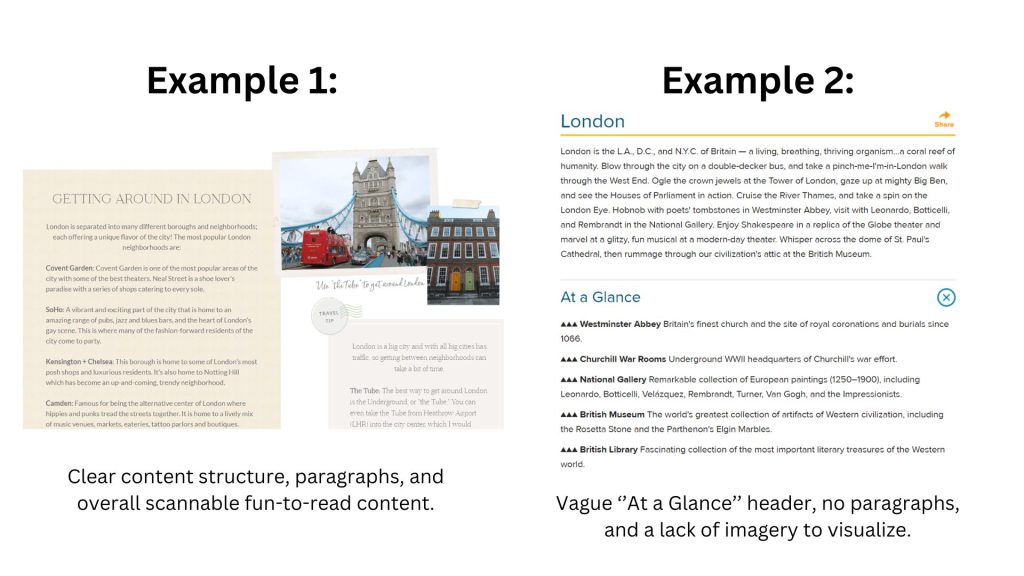
Do not get me wrong, both of these articles are amazing.
In fact, the 2nd article, which appears to be slightly boring, is actually an expert article written by an actual London tour guide.
But if your article is hard to consume and does not look scannable, most readers would just bounce.
Needless to say, the 1st ”pretty” example outranks the 2nd ”expert-but-boring” example.
To have scannable content, make sure to:
- Include imagery for visualization
- Do not write long sentences and break them into different paragraphs
- Explain in the H2 or H3 header what the following content will be about – avoid being vague unless you have to be vague (e.g. ”secret”)
Tip #3: Write a catchy title
Similar to making your content scannable, your article title itself should be catchy.
In SEO language, catchy titles improve your organic click-through rate, that is, the amount of people who see your article and click on it.
Now, what is a ”catchy” title? SEOs would differ here.
Some writers would argue that the title should have emotional words, such as ”secret”, ”proven”, or ”huge.”
I think that this definitely worked in the past.
But ever since YouTubers went too deep with their click-bait titles that promised things they couldn’t deliver, SEOs have been switching off their strategies.
In fact, Google in the Content Quality Update hinted something about this:

My personal approach to titles is to keep the structure of the main question (which also helps for SEO) and add a little extra at the end that would tease the content.
In the case of this article, ”How to Write an SEO-Optimized Blog Post”, I have kept the structure and added an extra ”Step-by-Step” at the end to signal that there will be a process inside.
From an On-Page SEO standpoint, the title length should be kept up to 55 characters, but going a little bit over that would not be problematic.
Your goal is simply to capture the readers’ attention by being slightly different than your competition on the SERPs.
Tip #4: Optimize the page speed
The reality is that, no matter how catchy your title is and how amazing your content is, if it’s loading slowly, both Google and your users will be upset about it.
Your page speed depends on how heavy your page is, and how good your hosting is at handling it.
Here’s how you can optimize your page speed on a page level:
- Optimize your images – your images should not be over 150-200 KB. You can use compression tools such as TinyJPT
- Improve your hosting plan – you want to have a dedicated server for your domain, although that can’t be helped if you are running on a low budget
- Do not upload heavy videos or too much unnecessary code, such as dozens of tracking scripts or JavaScript applications
As long as you have good hosting and light images, your website speed should be fine. To analyze your current performance, you can use free tools such as Google’s PageSpeed Insights.
Tip #5: Utilize writing software for grammar and correctness
Grammar matters for SEO, even though it’s not a ranking factor.
According to SEO.com, when your content contains grammatical mistakes, such as misspelled words, you affect your content’s authoritativeness and trustworthiness.
Grammar and the quality of your English, or any language, signal the content quality.
In order to not worry about that, I usually use grammar tools such as Grammarly to help me with easy-to-miss mistakes.
You can take it a step further and use more complicated software for advanced recommendations, but you would be well off just with the free plan of Grammarly.
Tip #6: Update the content from time to time
The search engines care about content freshness.
After all, a London guide written or updated in 2023 should theoretically be more relevant than one written in 2020.
This is why you should update your content from time to time, usually once or twice a year, depending on how competitive is the niche.
And the update doesn’t have to be that much of a big deal either – it could be as little as adding 1 more sub-section with 200 words in it. Or updating the data and internal links.
The goal is to show Google and your readers that your content is up-to-date with the industry’s best practices and trends.
Tip #7: Add uniqueness and your own opinion(s) on the topic
Do not simply write what everyone else has written on the topic.
It’s important that you know about Google’s E-E-A-T framework for evaluating content authority.
The abbreviation stands for ”Experience, Expertise, Authoritativeness and Trustworthiness”.
Notice how there is ”Experience” in it. This is because Google has started, quite recently, prioritizing content where the content creator has experience on the topic.
And from a user perspective, you’d much rather read a London guide from someone who has been there, rather than someone who has only read about the city and it repeating what the others are saying.
How to show that you have experience? It’s in the way you talk.
You can start sentences such as ”I think”, ”In my opinion” or ”When I was there”.
Tip #8: Write for humans and not for engines
Lastly, your content should be written for humans, not for engines.
You are dealing with humans who have emotions, short attention spans, and are judgemental of what content they consume.
Google has stated that they are looking for human-first and not engine-first content.
This is why old-school practices such as keyword stuffing (repeating the main keyword as many times as possible and adding out-of-context long-tail keywords) are outdated and will get you punished.
Conclusion & Key Takeaways: Writing the Perfect SEO-Friendly Article
Content creators should not obsess over the idea of creating the perfect article for Google, but the perfect article for their readers.
Naturally, there are techniques and best practices in order to rank higher, but they should not come at the expense of the readers.
Here are the key takeaways from the article:
- Come up with a 1 primary and multiple secondary keywords for your blog
- Analyze the SERPs and the competition – notice how much they have written on the topic and the sub-topics they cover
- You can use SEO tools like LowFruits to help you with SERP analysis and long-tail keyword research
- Focus on creating the correct content outline as that is getting half of the work done – split it into H2s and H3s
- Write unique content for humans – do not just repeat what everyone has stated on the topic
- Bring your own unique perspective and experience – Google values topical experience
- Update the content from time to time – keep up with the trends and industry changes
- Optimize the site and blog for page speed – slow-loading websites make users bounce off
- Grammar matters, and you can use tools such as Grammarly to help you with that
- Write a catchy headline in order to improve the organic click-through rate
- Make your content scannable and easily readable to improve the time users spend on the page
- Build internal links and link it to other relevant articles within the website
Awesome. Just what I needed!